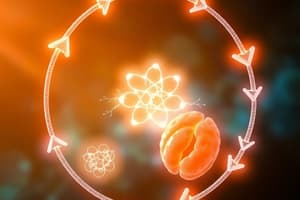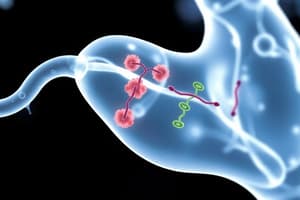Podcast
Questions and Answers
What is the primary role of anaplerotic reactions in the citric acid cycle?
What is the primary role of anaplerotic reactions in the citric acid cycle?
- To regulate the flow of carbon atoms into the citric acid cycle
- To catalyze the conversion of pyruvate to acetyl-CoA
- To generate ATP during oxidative phosphorylation
- To replenish intermediates that are siphoned off into other pathways (correct)
What is the primary function of the citric acid cycle in aerobic organisms?
What is the primary function of the citric acid cycle in aerobic organisms?
- To synthesize fatty acids and amino acids
- To catalyze the breakdown of carbohydrates
- To serve in both catabolic and anabolic processes (correct)
- To generate ATP during oxidative phosphorylation
Which of the following reactions is NOT a site of regulation in the citric acid cycle?
Which of the following reactions is NOT a site of regulation in the citric acid cycle?
- Pyruvate dehydrogenase complex reaction
- Citrate synthase reaction
- Glycolysis (correct)
- Isocitrate dehydrogenase reaction
What is the starting material for the citric acid cycle?
What is the starting material for the citric acid cycle?
What is the purpose of allosteric and covalent modification in the regulation of the citric acid cycle?
What is the purpose of allosteric and covalent modification in the regulation of the citric acid cycle?
Which of the following is an example of an anabolic process in the citric acid cycle?
Which of the following is an example of an anabolic process in the citric acid cycle?
What is the result of the dynamic balance between anaplerotic reactions and the removal of intermediates for biosynthetic pathways?
What is the result of the dynamic balance between anaplerotic reactions and the removal of intermediates for biosynthetic pathways?
What is the purpose of the citric acid cycle in the oxidation of fatty acids?
What is the purpose of the citric acid cycle in the oxidation of fatty acids?
What is the role of the pyruvate dehydrogenase complex reaction in the regulation of the citric acid cycle?
What is the role of the pyruvate dehydrogenase complex reaction in the regulation of the citric acid cycle?
What is the significance of the citric acid cycle in aerobic organisms?
What is the significance of the citric acid cycle in aerobic organisms?
Flashcards are hidden until you start studying
Study Notes
Reactions of the Citric Acid Cycle
- The citric acid cycle is a cyclic pathway that takes place in the mitochondria and has eight steps.
- Mitochondria contain all the enzymes and proteins necessary for the last stage of respiration, electron transfer, and ATP synthesis by oxidative phosphorylation.
- The citric acid cycle is the site of most energy-yielding oxidative reactions and of the coupled synthesis of ATP in nonphotosynthetic eukaryotes.
- In photosynthetic eukaryotes, mitochondria are the major site of ATP production in the dark, but in daylight, chloroplasts produce most of the organism's ATP.
- In most bacteria, the enzymes of the citric acid cycle are in the cytosol, and the plasma membrane plays a role analogous to that of the inner mitochondrial membrane in ATP synthesis.
Steps of the Citric Acid Cycle
- The cycle begins with acetyl-CoA donating its acetyl group to oxaloacetate to form citrate.
- Citrate is transformed into isocitrate, which is dehydrogenated with loss of CO2 to yield a-ketoglutarate.
- a-Ketoglutarate undergoes loss of a second molecule of CO2 and ultimately yields succinate.
- Succinate is enzymatically converted into oxaloacetate, which is then ready to react with another molecule of acetyl-CoA.
Regulation of Glycolysis and Gluconeogenesis
- Three reactions of glycolysis are so exergonic as to be essentially irreversible: those catalyzed by hexokinase, PFK-1, and pyruvate kinase.
- Gluconeogenesis uses detours around each of these irreversible steps, with bypass reactions that also have a large, negative ∆G’.
- Simultaneous operation of both pathways would consume ATP without accomplishing any chemical or biological work, leading to a futile cycle.
Hexokinase Isozymes
- Hexokinase is a regulatory enzyme that catalyzes the entry of glucose into the glycolytic pathway.
- Humans have four isozymes of hexokinase, encoded by four different genes, which are affected differently by their product, glucose-6-phosphate.
Citric Acid Cycle as an Amphibolic Pathway
- The citric acid cycle is an amphibolic pathway, serving in both catabolic and anabolic processes.
- The cycle provides precursors for many biosynthetic pathways.
- Intermediates of the citric acid cycle are removed to serve as biosynthetic precursors and are replenished by anaplerotic reactions.
Regulation of the Citric Acid Cycle
- The regulation of key enzymes in the citric acid cycle ensures the production of intermediates at the rates required to keep the cell in a stable steady state.
- The flow of carbon atoms from pyruvate into and through the citric acid cycle is under tight regulation at two levels: the conversion of pyruvate to acetyl-CoA and the entry of acetyl-CoA into the cycle.
- Acetyl-CoA is also produced by pathways other than the PDH complex reaction, and the availability of intermediates from these other pathways is important in the regulation of pyruvate oxidation and of the citric acid cycle.
Studying That Suits You
Use AI to generate personalized quizzes and flashcards to suit your learning preferences.




